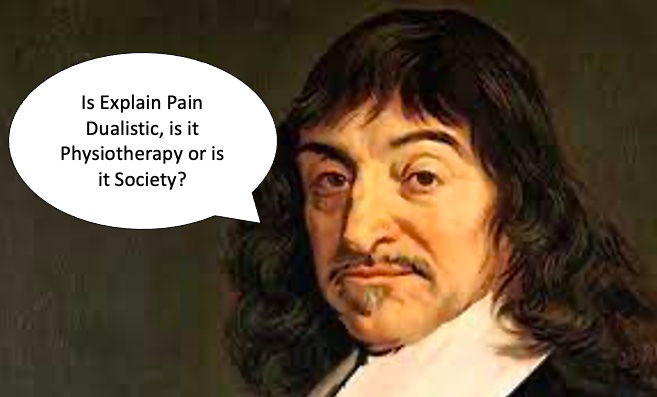When this question popped in my head, it sparked my curiosity. I had been reading through Explain Pain recently and I got a sense of something that perturbed me. I wondered if it had something to do with the necessity of the inherent nature of duality. So, as I often do, I thought I would share my musings in a blog.
Now this philosophy stuff is super-interesting and can be a bit hard to get your head around. So I’m going to break this blog into two parts in an attempt to make it a bit more palatable.
When I ask, “Is Explain Pain dualistic, is it physiotherapy or is it society?” I’m pondering on how each of the parts of the question could be looked at from a dualist point of view. Questions that arose for me during my reading include: What is the inherent nature of duality? Is there a philosophy that underpins the physiotherapy profession and society? What relevance does this have to EP? What might it mean going forward?
Before we get into these questions we should explore two concepts that continue to exist in physiotherapy, medicine and society today. That is the philosophy of dualism and the ontology of transcendence.
Dualism
In philosophy, dualism is distinguished by acknowledging the differences between two proposed categories (or substances) such as body and mind. This can also be extended to space and time, subject and object, pain and suffering, being and thought. For the purpose of this blog we will use the example of mind body dualism. Many will be familar with Renee Descartes proposition that the mind and body are distinct and separable. Yet, it wasn’t just Descartes who took this position, philosophers before him like Socrates, Plato, Aristotle were also dualists and pondered on the same issues of mind-body dualism.
Ontology of Transcedence
Through my reading, I have come to understand that throughout history the filter of dualism has structured many thoughts of philosophers with one of the two categories (or substances) being transcendent over the other. An ontology (theory of reality) of transcendence involves looking at things from a hierarchy. In the case of mind body dualism the physical realm (the body) is subservient to a superior one external to the body (During the Medieval period this would have been the existence of God, Descartes proposed the ‘Cogito’ or the subjective ideal different from the physical world, Plato and his world of forms). An ontology of transcendence proposes that reality is experienced through the ‘act of rising above something to a superior state.’ That there is a capital T truth to being, a grand narrative to life.
What do I mean?
Take medicine, there’s a component of what medicine does (and physiotherapy) that suggests a way of being, how people “should” be. We look at discs, joints, tissues and categorise them based upon what is normal vs abnormal. In physiotherapy we use biomechanics to assume there is a “normal way to move” or an “ideal posture”. The Vitruvian man created by Leonardo Da Vinci is a good example of the ideal “normal” person, perfectly symmetrical, perfect body proportions. Anything outside of that is classed as “abnormal or pathological.” Thus the ideal being would be one that is proposed to be “normal”.
Two examples that spring to mind here are:
- Consider the DSM or ICD to see how problematic it is to categorise people into dualist categories of normal and abnormal.
- The challenge of reconciling the pain – nociception debate. Think of the many studies of asymptomatic pathologies resulting in a pain-nociception paradox.
Therefore, are we trying to get people to fit into a template of how we think they “should” be?
This is a good place to stop. I’ll continue the remainder of this blog in the next month or two as it take’s a lot of time to read, re-read, consolidate, ponder, read again, write, read again… you get the drill.
Thanks for having a read.
TNP


Leave a comment